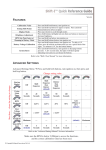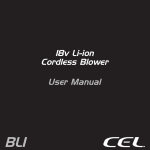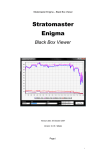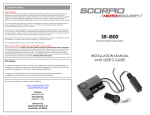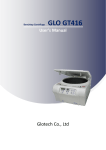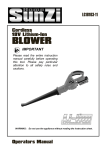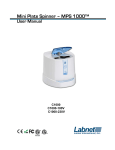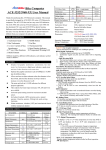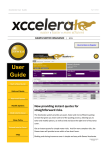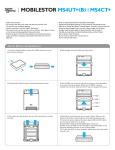Download Shift-I Installation and Quick Start Guide V1.4
Transcript
INTRODUCTION Welcome to your Shift-I™ quick start guide. Please take the time to read this first page. It provides a good overview to the philosophy behind using a progressive shift indicator. For those who cannot wait to play, skip to the next page and return here at your leisure. Philosophy Knowing the optimal RPM range can be particularly useful for both circuit work and on the street. It can provide a reference for shifting down, by indicating if your RPM is below the start of the power curve, and will also indicate if your RPM is getting too high to accelerate out of the turn. In addition, the Shift-I can be used to optimize launch control by keeping the RPM within the ideal range. By indicating the section of RPM your most interested in, it allows you to break out of old habits and form new ones. This can increase both performance, control and engine life. Importantly, this is achieved without taking your eyes off the road! Shift-I™ Shift-I™ is a progressive gear shift and RPM range indicator. The lights are user programmable to indicate a required section of your RPM, the first light illuminating at the RPM you have programmed, usually this will be the start of the power band, and depending on the display mode selected will terminate with all lights flashing at your programmed shift point. The lights in-between are automatically set at equal RPM divisions. Why seven lights? Extensive testing determined that within your peripheral vision you can instantly and easily recognize how many of the seven lights are illuminated. Any more and you need to concentrate, removing your attention from the road. Any less and RPM trend information is lost. As you accelerate, you will see each light come on, providing a predictable lead up to when the ideal shift point occurs. Installation, Setup & the User Manual The good news is that despite the large number of user defined settings you can tweak on your Shift-I™, there are only two that need to be set before the unit can be used correctly. This guide will cover these two settings after the installation section. The “User Manual” (other booklet) provides the specific details on all the features and how to configure them. One feature in the User Manual that you should be aware of, is the brightness control (page 8). Please make sure to adjust the brightness before using the Shift-I™, particularly if it is too bright. INSTALLATION SHIFT-I™ WIRES Shift-I requires only three wires to be connected, Ground, Ignition and Tacho. Ground and ignition are commonly found at the back of the main instrument. The tacho can be connected to either a digital signal from the engine controller unit (ECU) to the instruments tacho (if available), or by connecting to the low side of the ignition coil. Connecting to the coil is possible for transistor type ignition. If in doubt, please contact Ecliptech. The diagrams below show the different ways the “Shift-I Tacho Wire” can be connected. Black = Ground Wire Black/Red = Ignition Wire Black/Blue = Tacho Wire You cannot damage Shift-I™ by connecting the wires around the wrong way, however it is strongly recommended not to incorrectly make wire connections to avoid blowing fuses and/or damaging the electrics. If you are not keen on installing it, or if you don’t have the required skills and/or tools, obtain help from an auto electrician. Failure to install and mount the unit correctly could result in making the vehicle unsafe to use. The easiest method for installation is to know what wire colours to look for and where to find them. A wiring diagram is the best option, alternatively you can search the internet or contact Ecliptech. Connect one wire at a time! This avoids confusion and the possibility of accidentally shorting the wires together. The wires must be correctly crimped or soldered to ensure proper and trouble free operation. When testing the wires, if possible find the connector in the wiring harness and gently probe the connector terminals. Sometimes it is easier to probe from the rear of the connector. Otherwise you will need to remove a small amount of insulation to test the wire. If you feel inclined and can’t wait to see it light up… put the black wire on the negative terminal of your battery, and the black/red wire on the positive. You won’t damage it if you get them round the wrong way. Motorbike manufacturers keep some level of consistency with their wiring colours, as show in the table below. Ecliptech may have your specific make/model/year on file. Manufacturer Ground Ignition Tacho Ducati Honda Kawasaki Suzuki Triumph Yamaha Violet or Light Blue Black/Brown or White/Green Brown/White Orange/Green or Red/Yellow Green/Red Light Brown or Red/Yellow Green/Yellow or Green/Grey Yellow/Green Light Blue Yel/Blue, Yel/Black or Black/Blue Red Yellow/Black Black Green Black/Yellow Black/White Black Black Car wiring is significantly more diverse. If you don’t have a wiring diagram of the cars electrics, the following sections may be of use. VERIFYING OPERATION Finding Ground Step 1 – Verify power is connected To verify a wire is connected to ground, you need to measure it’s resistance with a multimeter to the negative terminal of the battery (or good earth point). Set the multimeter to resistance or ohms ( ) setting, put one lead on the negative battery terminal and the other on the wire. The reading should be less the 1 , even if ignition is turned on. The lights should light up successively as soon as ignition is turned on, then shortly after you’ll see a few lights turn on (usually 3 or 4). If so, go to step 2. NOTE: Do not connect Shift-I’s ground wire to the frame! Connect it though the wiring to ensure the unit gets a good clean ground signal, which is needed to accurately read the tacho signal. 2. Does everything else work… if not, you may have accidentally shorted some wires during installation. Check all fuses. Don’t forget there may be a separate main fuse located near the battery. Finding Ignition 4. Check the ignition and ground wire to make sure you got the right ones. With ignition on, measure the voltage at the Shift-I™ to ensure power is there. Troubleshooting 1. Make sure you have plugged all connectors back together after wiring. To verify a wire is connected to ignition, you need to measure the voltage with a multimeter. Set the multimeter to voltage (V), put the black lead on the negative battery terminal and the other on the Shift-I’s black/red wire. With ignition off, the voltage should be less than 0.5V. With ignition on, it should read ~12V, or almost identical to that measured by placing the red multimeter lead on the positive battery terminal. If the engine is running, the voltage will most likely be ~13 to ~15V. Step 2 – Verify Tacho is Connected When you first turn on ignition, it will show battery voltage. As the Shift-i™ is not yet calibrated to the vehicle, press either button to exit this mode. Start the engine. In the majority of installations, the first light will come on at either 500, 1000, 2000 or 4000 RPM. The second light would then come on at twice this value. If this is the case, skip to the next page. NOTE: Do not connect this wire straight to battery, as it must be connected to the ignition to access the programming options. If the RPM is not being registered, first reset the Shift-I to default settings by holding down both buttons, turn ignition on and keep holding. After about 5 seconds, the display will flash rapidly indicating a successful reset. Release buttons and try again. TIP: Although not specifically required, if you later intend on calibrating the voltage (refer to advanced feature section of user manual), then now is a good time to write down the measurements… Make sure the tacho wire is properly connected to the correct wire on the vehicle. Battery voltage at battery (measure directly across battery terminals) = Battery voltage at Shift-I (measure directly at Shift-I wires) = If necessary, try increasing the calibration value (page 4 of the user manual) and later increase the input sensitivity (page 17 of the user manual). Finding Tacho Signal To verify a wire is connected to the tacho signal, you need to measure the frequency (Hz) with a multimeter. Set the multimeter to frequency, put the multimeter’s black lead on the negative battery terminal and the multimeter’s red lead on the Shift-I’s black/blue wire. With ignition on and the engine running, the frequency should vary with RPM. Some multimeters may have trouble reading the tacho signal. ! CONFIGURING THE SHIFT-I™ RPM Set-Points The two settings that need be set are the calibration value and the RPM set-points. You can set when the first light turns on, and also when they flash (given the default display mode). The lights in between are automatically calculated. This section shows how to change it. Calibration Value When ignition is turned on, the display will first show the rpm display mode, then shortly after the battery voltage display. Press either button to exit battery mode (this makes things less confusing) and the display will go blank. Setting the correct calibration value ensures your Shift-I™ is synchronized with the vehicle it is fitted to. The RPM signal sent to the Tachometer, usually a series of pulses, varies greatly between different manufacturers and models. Some will use two pulses per revolution, some more, some less, therefore a “calibration value” setting is provided. Press and hold the down button, after a couple of seconds the display will change. The five lights on the left are used to represent the value of the lower RPM set-point (first light). To read the value, just count how many times each light flashes, which represents the number. For example, a value of 12,500rpm would flash the left most light once (1), the next one twice (12), the third one 5 times (125) and the remain two remain solid (12500rpm). Press up or down to increase or decrease the value, then press both buttons at once to save (or rev the engine over 2,200rpm to save). Setting the upper RPM set-point is similar, except press and hold the UP button instead. The five lights are now also on the right hand side. Using the correct setting is VERY important, as many of the units functions are dependant on the RPM value as seen by the unit. For example, most functions are locked out if the RPM is above 2,200. With the wrong calibration, functions may be locked out at idle! The easiest way to determine the correct calibration setting is simply to just try it! The unit is pre-programmed for the first light on the left to illuminate when it believes the RPM is 1,000 (using the default calibration of 2). You can change these settings while the engine is running (and vehicle stationary), however if over 2,200rpm, the menu will be locked out. See page 5 of the “User Manual” for more detail. Start the engine and increase the RPM slowly to check if the first light comes on at 1,000 RPM, the second at 2,000 RPM, third at 3,000 RPM etc. If the first light does indeed come on at or near 1,000 RPM, then the default calibration value is correct. If not, consult the table below to determine what the calibration setting should be (typically 0.5, 1, 2 and 4). Please note: If the first light comes on at 950 RPM (tacho inaccuracy), this is still the 1,000 RPM point to be used in the table below. MOUNTING THE DISPLAY Two high performance acrylic adhesive foam pads are included, which have excellent resistance to ageing, water, most solvents and UV light. They stick really well to plastic, but not to vinyl (particularly those with protective waxes applied). They can be safely removed, however if in doubt, first test an area with a small piece in an appropriate place. Clean the surfaces before applying the adhesive pads. To change the calibration, you need to enter the calibration setting mode. With the ignition off, press and hold both buttons, turn the ignition on and then release the buttons. If it is the first time you have entered this mode, you will see the first two lights are illuminated, indicating the default value of 2. Press up or down to change the settings, and then press both buttons to save. You can re-enter the calibration mode to verify your setting if you wish. Test the new setting. 1st Light 4,000 2,000 1,333 1,000 800 667 500 400 333 250 2nd Light 8,000 4,000 2,667 2,000 1,600 1,333 1,000 800 667 500 3rd Light 4th Light 5th Light 12,000 6,000 4,000 3,000 2,400 2,000 1,500 1,200 1,000 750 16,000 8,000 5,333 4,000 3,200 2,667 2,000 1,600 1,333 1,000 20,000 10,000 6,667 5,000 4,000 3,333 2,500 2,000 1,667 1,250 Immediately after application, they can be removed or re-positioned without great effort. The pads take a couple of days to achieve the maximum bond strength, after which, they will most likely tear apart before coming off. Usually the remains can be rubbed off (without leaving a residue), and without any chemicals. CALIBRATION ACTION DISPLAY AFTER VALUE REQUIRED ACTION REQUIRED 0.5 Press Down 3 Times 1 Light flashing 1 Press Down 2 Times 1 Light On 1.5 Press Down Once 1 Light On, 1 flashing 2 DEFAULT - No Action 2 Lights On 2.5 Press Up Once 2 Lights On, 1 flashing 3 Press Up 2 Times 3 Lights On 4 Press Up 3 Times 4 Lights On 5 Press Up 4 Times 5 Lights On 6 Press Up 5 Times 6 Lights On 8 Press Up 6 Times All Lights On The Shift-I™ must be mounted behind a windscreen, where it is not subjected to the wind pressure or rain. Choose a place to mount the unit where the lights are clearly visible and it do not interfere or obstruct the drivers view. Do not place it in a location where the headlights from another vehicle are incident on the display, as the light sensor will assume it is daylight and automatically increase the brightness. Test the brightness level is suitable in both light and dark conditions, and adjust as required (see User Manual, page 8). " #




